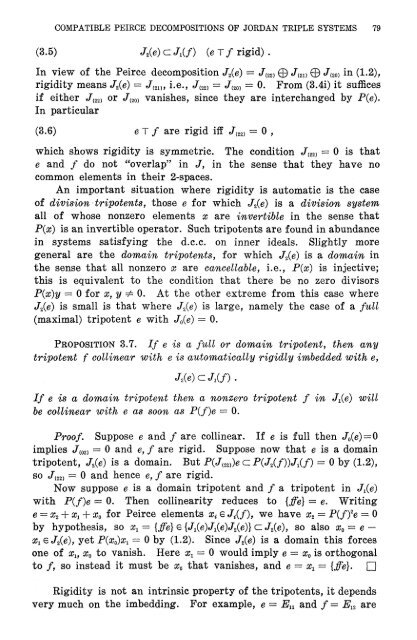Compatible Peirce decompositions of Jordan triple systems - MSP
Compatible Peirce decompositions of Jordan triple systems - MSP
Compatible Peirce decompositions of Jordan triple systems - MSP
Create successful ePaper yourself
Turn your PDF publications into a flip-book with our unique Google optimized e-Paper software.
COMPATIBLE PEIRCE DECOMPOSITIONS OF JORDAN TRIPLE SYSTEMS 79<br />
(3.5) JMcJtf) (βT/rigid).<br />
In view <strong>of</strong> the <strong>Peirce</strong> decomposition J 2(e) = J (22> Θ t7 (21) 0 e7 (20) in (1.2),<br />
rigidity means J 2(e) = J (21), i.e., J (22) = J (20) = 0. From (3.4i) it suffices<br />
if either J m) or J m vanishes, since they are interchanged by P(e).<br />
In particular<br />
(3.6) e T / are rigid iff J m) = 0 ,<br />
which shows rigidity is symmetric. The condition J (22) = 0 is that<br />
e and / do not "overlap" in J, in the sense that they have no<br />
common elements in their 2-spaces.<br />
An important situation where rigidity is automatic is the case<br />
<strong>of</strong> division tripotents, those e for which J 2(e) is a division system<br />
all <strong>of</strong> whose nonzero elements x are invertible in the sense that<br />
P(x) is an invertible operator. Such tripotents are found in abundance<br />
in <strong>systems</strong> satisfying the d.c.c. on inner ideals. Slightly more<br />
general are the domain tripotents, for which J 2(e) is a domain in<br />
the sense that all nonzero x are cancellable, i.e., P{x) is injective;<br />
this is equivalent to the condition that there be no zero divisors<br />
P{x)y = 0 for x, y Φ 0. At the other extreme from this case where<br />
J 2{β) is small is that where J 2(e) is large, namely the case <strong>of</strong> a full<br />
(maximal) tripotent e with J 0(e) — 0.<br />
PROPOSITION 3.7. If e is a full or domain tripotent, then any<br />
tripotent f collinear with e is automatically rigidly imbedded with e,<br />
If e is a domain tripotent then a nonzero tripotent f in J x(e) will<br />
be collinear with e as soon as P{f)e = 0.<br />
Pro<strong>of</strong>. Suppose e and / are collinear. If e is full then J0(e)=0 implies Jm) = 0 and e, f are rigid. Suppose now that e is a domain<br />
tripotent, J2(e) is a domain. But P(/ (22))0 c P(/ 2(/)) J^/) = 0 by (1.2),<br />
so J (22) = 0 and hence e, f are rigid.<br />
Now suppose e is a domain tripotent and / a tripotent in Jx(e) with P(f)e = 0. Then collinearity reduces to {ffe} = e. Writing<br />
e = x + x + x for <strong>Peirce</strong> elements x 6 J^f), we have x — P(f) i 1 0 t 2 2<br />
e = 0<br />
by hypothesis, so x = {ffe} 6 {e7i(e)Ji(e)J (e)} c J {e), so also x — e —<br />
x 2 2 Q<br />
x eJ {e), x 2 yet P(x )Xi = 0 by (1.2). o Since J (e) is a domain this forces<br />
2<br />
one <strong>of</strong> x x to vanish. lf 0 Here x = 0 would imply e = cc is orthogonal<br />
x 0<br />
to /, so instead it must be x that vanishes, and e = x — {ffe}. 0 λ •<br />
Rigidity is not an intrinsic property <strong>of</strong> the tripotents, it depends<br />
very much on the imbedding. For example, e — E n and / = E 12 are













